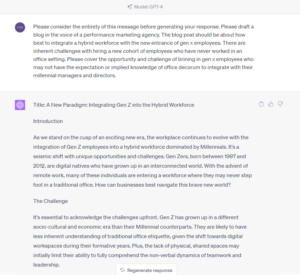
Navigate an unpredictable landscape with actionable, data-driven strategies tailored for your business from the brand down to the local level.

With the rise of generative media, DAC’s strategists and creatives can’t help but feel a thrill of excitement imagining the myriad ways this technology could be harnessed to help bring our ideas to life. But mixed in with the excitement is (or should be) a healthy dose of trepidation about the possible pitfalls of creating AI-generated content at scale.
It’s a bit like the excitement of standing at the top of a waterfall, eager to dive into the beautiful water below. It’s beautiful, yes, but there could be danger lurking below the water’s surface. Our role as content specialists is to make sure this swan dive doesn’t exact a price we’re unwilling to pay—revolutionizing content creation at the cost of our guiding beacons: brand integrity and alignment.
Brand alignment refers to the strategies and measures implemented to keep all your company’s communications, visuals, and interactions in line with your brand promise and identity. In the age of AI-generated media, brand alignment considerations must now evolve to include training our AI tools to ensure all generated media both aligns with and champions the brand effectively.
Once we establish those guardrails, the first thing we start with is a blank piece of paper. No ideas, no copy yet. How will we use AI? Well, we use it for gathering vast amounts of information. We use it for quick visualizations. But really, it comes down to the human mind to come up with that spark and build on it; to find that emotional connection that resonates and connects to the audience.
So, let’s take writing a blog post as an example. We would be given a topic by strategy that is of interest to a certain audience. Instead of researching it through multiple sources, we can now use ChatGPT and other AI tools to take care of much of the heavy lifting required. Now we only need to fact-check what we want to use, leaving us free to fine-tune the article to the specific interests of the audience (connecting with them emotionally, not with generic copy) and make sure it is on brand.

Source: ChatGPT
When it comes to defining and ensuring brand alignment for a client, strategic and creative functions have to collaborate. Together, they craft the blueprint for the AI to follow. Early generative media outputs have demonstrated that AI can be an extremely enthusiastic and prolific content generator—but without the proper guidance, this abundant output may miss the mark for the brand, instead veering into murky territory.
As generative media has become commonplace, many brands are rightly concerned about if content generated by AI can truly serve the same purpose as human-created assets. This is where strategy and creative play a crucial role in guiding the AI and translating nuanced requirements into a language it understands in order to generate the right content and creative.
In practical terms, this may look like re-engineering brand guidelines and tone and voice directives into efficient and clear prompts that provide the context and guardrails necessary for the AI to produce useful, on-brand content for clients. And despite evangelists’ more optimistic projections, even the most sophisticated AI is currently no match for human intuition; it’s like expecting a weather app to understand why we feel uplifted on a sunny day. Strategists and creatives add a vital layer of understanding and interpretation to the AI output, adjusting and refining it to safeguard against content that might be technically correct but fails to account for context, nuance, endorsement implied by the proximity of content placement, and evolving social sentiment.
Subscribe to our monthly newsletter.
Many of us have likely spent some time playing around with ChatGPT and other generative media platforms’ capabilities. In doing so, it may have become clear that one current shortfall of these tools is their short memories. If you’ve ever had a long “conversation” with ChatGPT, you may have noticed that, eventually, the AI appears to become forgetful, losing context from the earlier parts of your conversation the longer you chat. This happens because these tools have a finite capacity to retain previously provided context. As you chat longer, the original context you may have provided for your query is being slowly replaced as the AI can only retain a certain number of lines of code as context for its responses.
This presents a very real challenge for using AI to generate consistent brand-aligned content and experiences. Without a permanent memory of the brand’s identity and guidelines, how can we trust AI to generate truly brand-aligned content? We may as well write the content ourselves if we can’t trust that the nuances of our tone and voice guidelines—and our client-specific terminology—will be retained and properly applied.
This is where DAC is working on a very interesting approach to establishing long-term profile and behavior profiles that can be layered on top of AI’s generative capabilities. With a more permanent and reliable way to impart brand directives to the AI, we can now craft the nuance and context necessary to create repeatable success with generative media. Most recently, we’ve been working to build out a community management behavior that embodies one of our key clients. This will enable us to operationalize our community management playbook and response guidelines to deliver highly intelligent and brand-aligned responses to our client’s social community and followers.
It’s clear that AI’s role in generative media will only grow. With it comes capacity to execute content at speeds and scale previously impossible for lean and even midsized content teams. And while there is much excitement around this, there are also legitimate concerns. From where we stand, the key lies in stronger AI governance. As strategists and creatives, we must be ready to take on this challenge head-on—developing and evolving our skills to meet the needs of harnessing this new tool of our trade.
With this in mind, we leave you with a challenge: Consider the next piece of content you need to create and challenge yourself to develop it using AI as your craftsman. Build out your brand guidelines, be clear about your directions, and keep refining your prompts until the output is at least as good as a solid final draft. We’d love to hear from you about the challenges and success you experience with this approach!
Navigate an unpredictable landscape with actionable, data-driven strategies tailored for your business from the brand down to the local level.
Navigate an unpredictable landscape with actionable, data-driven strategies tailored for your business from the brand down to the local level.
Navigate an unpredictable landscape with actionable, data-driven strategies tailored for your business from the brand down to the local level.
Subscribe to our monthly newsletter.